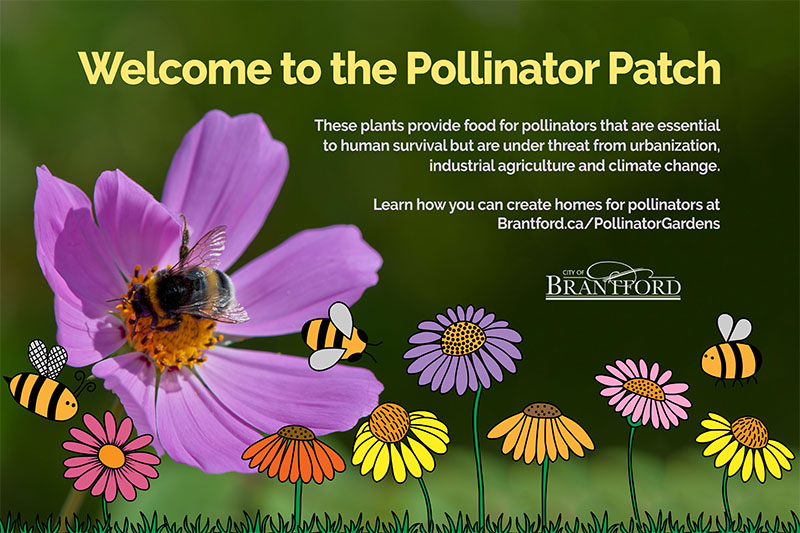The world’s food supply depends on pollinators. Fruit & seed production depend on pollen being moved from one flower to the next by insects, birds and even some mammals. Pollinators are responsible for bringing us one out of every three bites of food as well as supporting healthy ecosystems that clean the air, stabilize soils, provide protection from severe weather, and support other wildlife.
Many pollinator populations are unfortunately in decline -attributed mainly to a loss in feeding and nesting habitats. Pollution, the misuse of chemicals, disease, and changes in climatic patterns are all contributing to shrinking and shifting pollinator populations.
Adding habitat helps – even in cities and home gardens! Small gardens can and do attract pollinators and in many cases suburbs and cities have been shown to have more diverse pollinator communities than nearby wildlands.
| Tips for Creating Pollinator Gardens |
|
Ideal pollinator gardens include the following:
- food sources – such as pollen and nectar from native flowers
- nesting and overwintering sites – such as bare soil, hollow stems, and leaves
- larval host plants – such as milkweed
Plant selection and garden maintenance are important considerations in creating places for pollinators
Planting tips:
- Plant native: Choose native plants, trees and shrubs rich in pollen and nectar. Locally grown and pesticide free plants are best.
- Plant host plants: Butterflies lay their eggs on specific plants. Monarch butterflies, for example, will only lay their eggs on milkweed, the sole food source for their larva.
- Provide continuous bloom: Pollinators need a continuous source of pollen and nectar so select a variety of plants that will bloom from spring to fall.
- Mass plantings: Planting multiples of the same plant together in large groupings makes it easier for pollinators to find and collect pollen.
- Plant single bloom varieties: The petals of double or triple bloom varieties can block access to pollen and nectar.
- Prevent the spread of invasive plants: Monitor your property for invasive plants and remove them when detected. The invasive dog-strangling vine has a negative impact on Monarchs – female butterflies mistakenly lay their eggs on it since it’s in the milkweed family, instead of native milkweeds, causing their larvae to starve.
Other garden elements:
- Provide water: A birdbath or shallow dish of water with half submerged rocks will help bees and butterflies quench their thirst.
- Provide sun: Butterflies like to bask in the sun, so place a few flat rocks in sunny, sheltered locations.
Maintenance tips:
- Limit mulch: Many native bees build nests in soil, so leave some bare patches of soil and limit your use of mulch.
- Leave dead stems: Some bees hibernate and lay eggs in hollow stems. If you do cut, leave the bottom 8 inches in place and bundle the cut stems and place them in your garden. Bundles of sticks and stems that are put out for yard waste collection too early in spring will often contain overwintering bees. In the spring, wait until temperatures are consistently above 10 degree Celsius before cleaning up your garden.
- Keep your dead wood: Large branches and decaying logs can be kept in a sunny spot to provide much-needed overwintering habitat for bees and other wildlife.
- Leave the leaves: Leave the leaves where they fall or rake them into your garden to provide overwintering habitat for butterflies.
- Avoid tilling: Keep large patches of land unmown and untilled to provide secure and undisturbed nesting sites for ground-nesting bees.
- Minimize manicuring: A perfectly manicured lawn is a food desert for pollinators. Natural gardens and lawns offer the most benefits for pollinators in terms of food and nesting spots.
- Reduce mowing: To avoid disturbing ground-nesting bees, mow your lawn less often and set the blade at the highest level possible.
- Prune and deadhead: Remove dead flower heads to encourage new growth and a longer flowering season.
- Avoid pesticides: Avoid plants/seeds treated with systemic insecticides, such as neonicotinoids. And don’t spray pesticides.
- Keep it natural: Converting a lawn or garden to concrete, gravel, mulch or artificial turf reduces valuable food and nesting sites.
|
| Pollinator Patch Locations |
|
There are a number of small pollinator patch plantings on City property throughout Brantford. Most of these plantings are recent and require time to fill in and become established. Look for this sign at the following locations.

- Trail Access @Scarfe Avenue /Grand River Avenue
- Lorne Park (15 Colborne Street West)
- Trail Access @ Wilkes Dam ( Dufferin Avenue), Rotary Centennial Waterworks Park
- SC Johnson Gardenscape, Wayne Gretzky Sports Centre (254 N Park Street)
|
| Get Involved |
|
In 2021 members of Equal Grounds Community Gardens inquired about planting pollinator patches at community garden sites to promote food/fruit production. This initiative undertaken with city staff and volunteer members or “rangers” of the David Suzuki Foundation Butterfly Way Project led to the planting of a canoe at the trail access at Scarfe Avenue and several other pollinator patches throughout the City.
The Brantford Butterfly Way Project is one of more than 100 community Butterfly Way projects across Canada where volunteers have come together to create pollinator friendly neighbourhoods.
|
| Additional Resources |
|
To learn more about the importance of pollinators and pollinator health:
To learn more about how to create a pollinator garden
To learn more about plants for a pollinator garden
|









 Subscribe to this Page
Subscribe to this Page